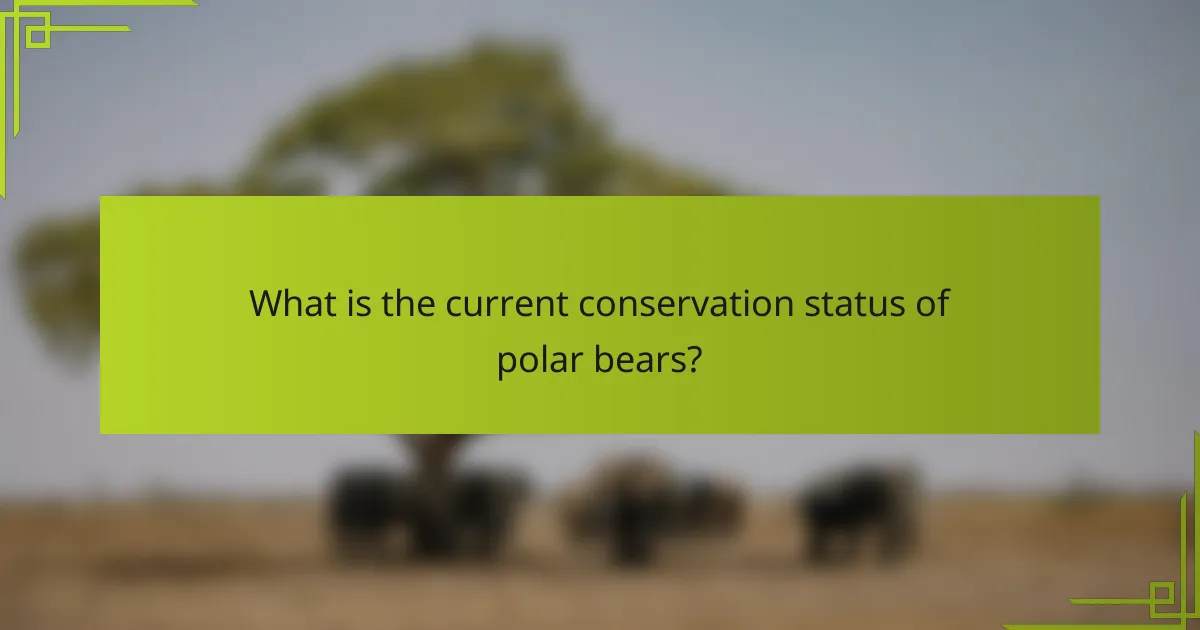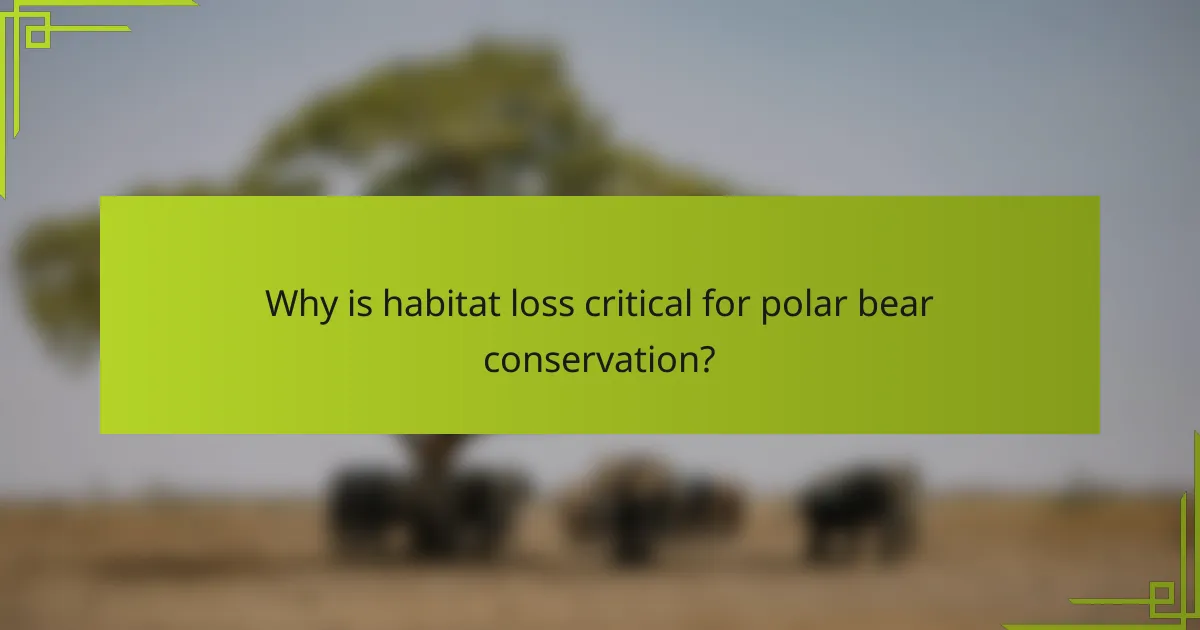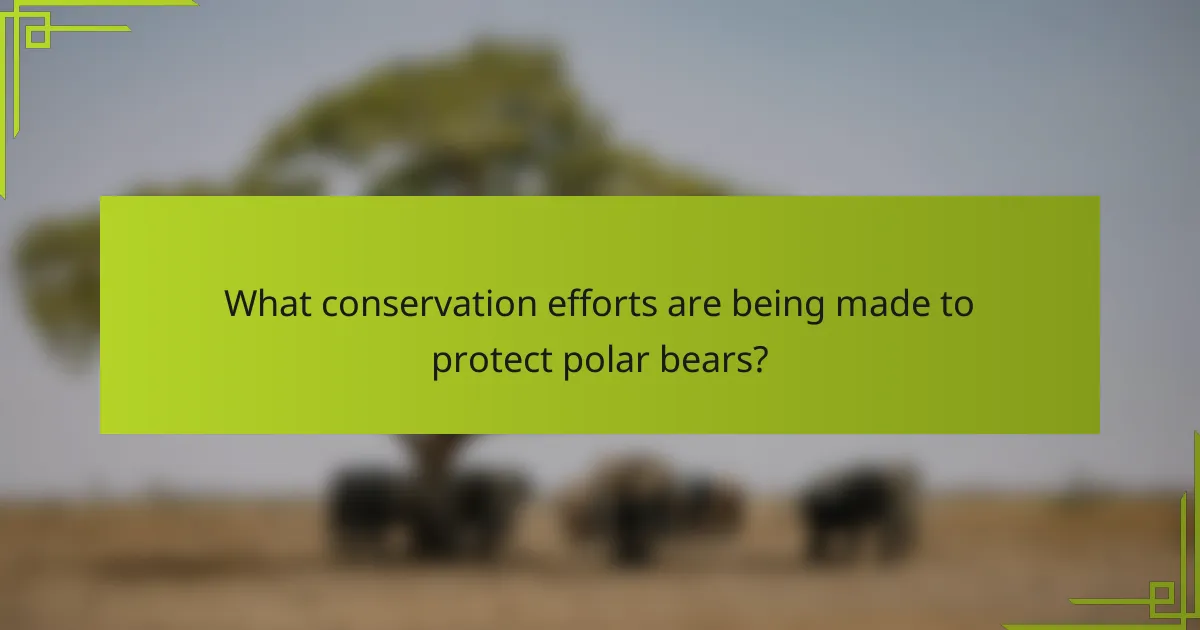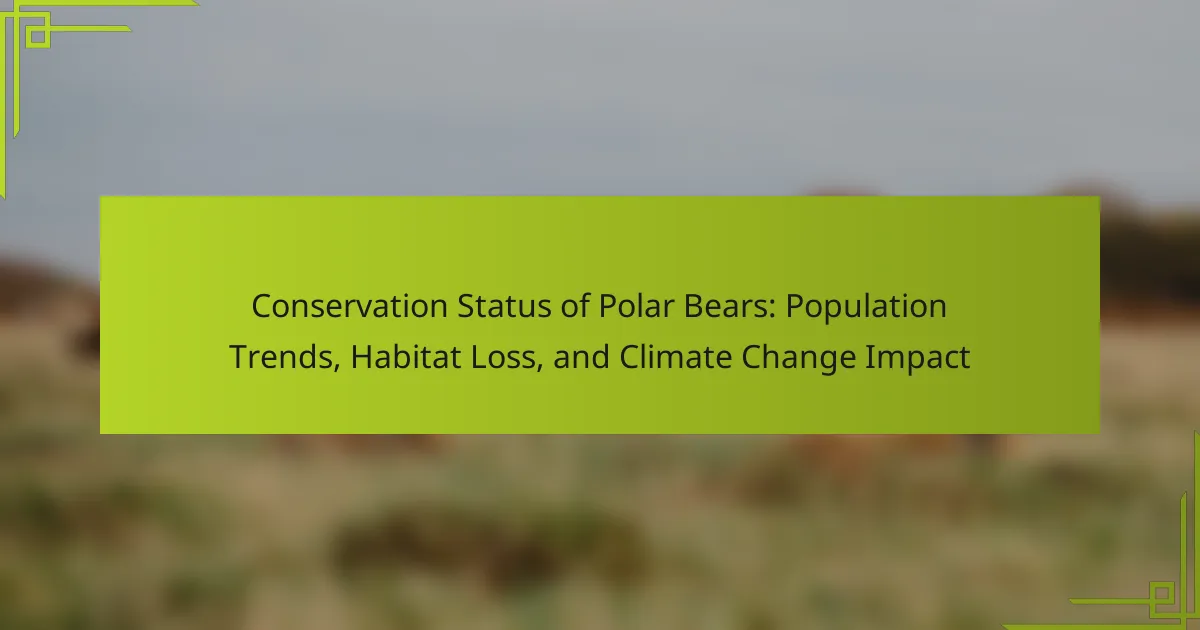Polar bears are currently classified as vulnerable by the International Union for Conservation of Nature (IUCN), indicating a significant risk of extinction in the wild. The primary threats to their survival include habitat loss driven by climate change, particularly the melting of sea ice, which is essential for their hunting and breeding. An estimated population of 22,000 to 31,000 polar bears faces challenges such as malnutrition and decreased cub survival rates due to reduced access to food sources. Conservation efforts are underway, focusing on habitat preservation, climate change mitigation, and international collaboration to protect polar bear populations from these escalating threats.

What is the current conservation status of polar bears?
The current conservation status of polar bears is listed as vulnerable by the International Union for Conservation of Nature (IUCN). This classification indicates that polar bears face a high risk of extinction in the wild. The primary threats to their survival include habitat loss due to climate change, specifically the melting of sea ice. According to the IUCN, the population of polar bears is estimated to be between 22,000 and 31,000 individuals. Ongoing research highlights the impact of declining sea ice on their hunting and breeding patterns. The situation is exacerbated by increased human activity in their habitats.
How is the population of polar bears currently trending?
The population of polar bears is currently declining. Research indicates that climate change is significantly impacting their habitat. Specifically, the loss of sea ice is reducing their hunting grounds. According to the U.S. Fish and Wildlife Service, polar bear populations in certain regions have decreased by up to 50% over the last few decades. Additionally, studies show that some subpopulations are facing serious threats due to environmental changes. Ongoing monitoring is essential to assess their conservation status.
What factors are influencing polar bear population changes?
Climate change is the primary factor influencing polar bear population changes. Rising temperatures lead to melting sea ice, which is crucial for polar bears’ hunting and breeding. The loss of ice reduces their access to seals, their main food source. Consequently, polar bears face increased starvation and lower reproduction rates. Additionally, habitat loss due to oil and gas exploration further threatens their survival. Human activities, such as shipping and fishing, also disrupt their habitats. Research indicates that polar bear populations in certain regions have declined by over 50% in recent decades. These factors collectively contribute to the ongoing challenges faced by polar bears.
How do researchers monitor polar bear populations?
Researchers monitor polar bear populations through various methods. They use satellite telemetry to track movements and habitat use. This technology allows for real-time data collection on polar bear locations. Researchers also conduct aerial surveys to estimate population sizes and distribution. These surveys involve counting bears from aircraft in specific regions. Additionally, genetic sampling helps assess population health and diversity. Researchers analyze hair and tissue samples to gather genetic information. They also use remote cameras to study behavior and population dynamics. Each method provides valuable insights into the status of polar bear populations.
What are the main threats to polar bear conservation?
The main threats to polar bear conservation include climate change, habitat loss, and human activities. Climate change leads to melting sea ice, which is crucial for polar bears’ hunting and breeding. Habitat loss reduces their access to food sources and breeding grounds. Human activities, such as oil exploration and shipping, increase risks of oil spills and disturbances. Additionally, increased shipping traffic can lead to encounters with humans, causing stress and injury. According to the International Polar Bear Conservation Plan, these factors significantly impact polar bear populations and their survival.
How does habitat loss affect polar bear survival?
Habitat loss critically affects polar bear survival by reducing their access to hunting grounds. Polar bears rely on sea ice to hunt seals, their primary food source. As climate change accelerates ice melt, polar bears face longer fasting periods. Research indicates that decreased sea ice leads to lower body condition and reproductive success. According to the U.S. Geological Survey, the population of polar bears in the Chukchi Sea has declined due to habitat loss. This decline in habitat directly correlates with increased mortality rates among polar bears. Without sufficient ice, polar bears struggle to find food, leading to starvation and decreased population numbers.
What role does climate change play in the decline of polar bear habitats?
Climate change significantly contributes to the decline of polar bear habitats. The primary impact is the melting of sea ice in the Arctic. Polar bears rely on sea ice for hunting seals, their main food source. As temperatures rise, sea ice forms later and melts earlier each year. According to the National Snow and Ice Data Center, Arctic sea ice extent has decreased by over 40% since the late 1970s. This loss of habitat forces polar bears to travel longer distances to find food. It also increases the risk of malnutrition and starvation. Additionally, habitat fragmentation reduces breeding opportunities. The decline in sea ice is thus critical to the conservation status of polar bears.

Why is habitat loss critical for polar bear conservation?
Habitat loss is critical for polar bear conservation because it directly impacts their ability to hunt and reproduce. Polar bears rely on sea ice as a platform for hunting seals, their primary food source. As climate change causes sea ice to melt, polar bears face reduced access to food. This leads to malnutrition and lower cub survival rates. According to the U.S. Geological Survey, two-thirds of the polar bear population could face decline by 2050 due to habitat loss. Additionally, habitat loss disrupts polar bear migration patterns. This makes it harder for them to find mates and establish territories. Consequently, habitat loss poses a significant threat to the overall survival of polar bear populations.
What specific habitats are polar bears losing?
Polar bears are losing sea ice habitats in the Arctic. Sea ice serves as a critical platform for hunting seals, their primary food source. As global temperatures rise, the extent and thickness of sea ice are diminishing. The Arctic sea ice minimum has declined by about 13 percent per decade since 1979. This loss threatens polar bear populations by reducing their access to food. Additionally, polar bears are losing coastal habitats due to rising sea levels and increased storm intensity. These changes disrupt their breeding and denning sites. The loss of these habitats directly impacts their survival and reproductive success.
How does melting sea ice impact polar bear hunting and breeding?
Melting sea ice significantly impacts polar bear hunting and breeding. Polar bears rely on sea ice as a platform for hunting seals, their primary food source. As ice diminishes, bears face difficulties in accessing their prey. This leads to increased energy expenditure and reduced body condition. Additionally, melting ice affects breeding by reducing denning sites. Female polar bears require stable ice for birthing and raising cubs. The loss of suitable habitats can lead to lower cub survival rates. Research indicates that polar bear populations are declining due to these factors. The overall health of polar bear populations is closely tied to the extent of sea ice.
What are the consequences of reduced habitat on polar bear health?
Reduced habitat negatively impacts polar bear health. Habitat loss leads to decreased access to food sources. This results in malnutrition and lower body condition. Poor nutrition affects reproductive success and cub survival rates. Additionally, reduced habitat increases stress levels in polar bears. Stress can lead to weakened immune systems and increased vulnerability to diseases. A study by Derocher et al. (2018) highlights that habitat degradation directly correlates with declining polar bear populations. As sea ice diminishes, polar bears are forced to swim longer distances, which can lead to exhaustion and increased mortality. Overall, reduced habitat significantly threatens the health and survival of polar bears.
How does climate change specifically impact polar bears?
Climate change significantly impacts polar bears by reducing their sea ice habitat. Polar bears rely on sea ice for hunting seals, their primary food source. As global temperatures rise, sea ice melts earlier in the spring and forms later in the autumn. This leads to longer fasting periods for polar bears. Research indicates that some populations have experienced declines in body condition and cub survival rates. According to the U.S. Geological Survey, polar bear populations in the Chukchi Sea have decreased by over 50% in recent decades due to habitat loss. Additionally, climate change alters the distribution of seals, further complicating hunting for polar bears. These changes threaten the overall survival of polar bear populations.
What are the observable effects of climate change on polar bear behavior?
Climate change significantly affects polar bear behavior. As the Arctic ice melts, polar bears are forced to travel longer distances to find food. This leads to increased energy expenditure and potential malnutrition. Polar bears are also spending more time on land due to reduced sea ice. This change affects their hunting patterns, making it harder to catch seals. Additionally, polar bears are observed to exhibit increased aggression and competition for food resources. Research indicates that these behavioral changes can lead to decreased reproductive success. The decline in ice habitat disrupts their natural patterns, impacting overall population health.
How does climate change alter the food chain for polar bears?
Climate change alters the food chain for polar bears primarily by affecting their primary prey, seals. As Arctic ice melts due to rising temperatures, seals lose their breeding and resting platforms. This decline in seal populations directly impacts polar bears, which rely on seals as a primary food source.
With less ice, polar bears have to swim longer distances to find food. This increased energy expenditure can lead to malnutrition and decreased reproduction rates. Studies show that polar bear populations are declining in areas where ice loss is most severe.
Additionally, changing ecosystems can lead to shifts in prey availability and distribution. The overall impact of climate change disrupts the delicate balance of the Arctic food web, threatening polar bear survival.

What conservation efforts are being made to protect polar bears?
Conservation efforts to protect polar bears include habitat preservation and climate change mitigation strategies. Organizations like the World Wildlife Fund (WWF) focus on reducing greenhouse gas emissions. Legal protections under the Marine Mammal Protection Act help safeguard polar bear habitats. Research initiatives monitor polar bear populations and health. Community engagement programs raise awareness about polar bear conservation. International agreements, such as the Polar Bear Conservation Plan, promote collaborative efforts among Arctic nations. These measures aim to address the threats posed by climate change and habitat loss.
What organizations are involved in polar bear conservation?
The organizations involved in polar bear conservation include the World Wildlife Fund (WWF), Polar Bears International, and the International Polar Bear Conservation Plan. WWF focuses on habitat protection and climate change advocacy. Polar Bears International emphasizes research, education, and advocacy efforts. The International Polar Bear Conservation Plan coordinates global efforts to protect polar bear populations. These organizations work collaboratively to address the threats to polar bears, such as climate change and habitat loss. Their initiatives include scientific research, policy advocacy, and community engagement to promote conservation strategies.
How do these organizations contribute to habitat preservation?
Organizations contribute to habitat preservation by implementing conservation strategies. They protect critical habitats through legal frameworks and designated protected areas. These organizations also conduct research to monitor habitat changes and species health. They engage in community outreach to raise awareness about habitat preservation. Funding initiatives support habitat restoration projects. Collaboration with governments aids in policy development for sustainable land use. These efforts help mitigate the impacts of climate change on polar bear habitats. For instance, the World Wildlife Fund has been active in Arctic conservation projects that directly benefit polar bear habitats.
What policies are being implemented to protect polar bears?
Policies to protect polar bears include the Marine Mammal Protection Act and the Endangered Species Act in the United States. These laws prohibit the hunting and harassment of polar bears. They also promote habitat conservation efforts. Internationally, the Polar Bear Conservation Plan encourages sustainable management practices among Arctic nations. The IUCN Red List classifies polar bears as vulnerable, prompting global awareness. Climate change mitigation policies aim to reduce greenhouse gas emissions affecting their habitat. Additionally, community engagement programs educate local populations on coexistence strategies. These combined efforts form a comprehensive approach to polar bear conservation.
What can individuals do to support polar bear conservation?
Individuals can support polar bear conservation by reducing their carbon footprint. This can be achieved by using energy-efficient appliances and reducing vehicle usage. Supporting renewable energy sources helps decrease greenhouse gas emissions. Individuals can also participate in local conservation efforts and donate to wildlife organizations focused on polar bears. Educating others about polar bear conservation raises awareness. Additionally, individuals should avoid products that contribute to habitat destruction, such as unsustainable seafood. Engaging in responsible tourism that supports conservation initiatives can also be beneficial. Lastly, advocating for policies that protect polar bear habitats can make a significant impact.
How can awareness and education help in polar bear conservation efforts?
Awareness and education significantly enhance polar bear conservation efforts. They inform the public about the threats polar bears face, such as climate change and habitat loss. Increased knowledge leads to greater public support for conservation initiatives. For instance, educational programs can engage communities in sustainable practices that protect polar bear habitats.
Research indicates that communities involved in awareness campaigns show improved conservation behaviors. A study by the World Wildlife Fund found that education initiatives led to a 30% increase in local support for polar bear protection measures. Furthermore, awareness campaigns can mobilize funding and resources for research and conservation projects.
In summary, awareness and education are crucial for fostering community involvement and driving effective conservation strategies for polar bears.
What lifestyle changes can individuals adopt to reduce climate impact?
Individuals can adopt several lifestyle changes to reduce climate impact. Reducing meat consumption can significantly lower greenhouse gas emissions. According to the Food and Agriculture Organization, livestock production accounts for 14.5% of global emissions. Using public transportation instead of personal vehicles decreases carbon footprints. The Environmental Protection Agency states that transportation is a major source of emissions in the U.S. Reducing energy use at home, such as using energy-efficient appliances, can lead to lower electricity consumption. The U.S. Department of Energy reports that energy-efficient homes can save up to 30% on energy bills. Embracing renewable energy sources, like solar or wind, decreases reliance on fossil fuels. Studies show that renewable energy can reduce emissions by up to 80% compared to fossil fuels. Recycling and reducing waste can also have a positive effect. The EPA notes that recycling can save energy and reduce emissions from waste disposal. Finally, supporting sustainable brands and products encourages environmentally friendly practices. These lifestyle changes collectively contribute to a significant reduction in individual climate impact.
What are the future prospects for polar bear conservation?
The future prospects for polar bear conservation are challenging but not impossible. Climate change significantly impacts their sea ice habitat, essential for hunting seals. As global temperatures rise, sea ice is projected to decline by 30% in the Arctic by 2050. This reduction directly threatens polar bear populations, leading to decreased access to food. Conservation efforts focus on habitat protection and reducing greenhouse gas emissions. Successful initiatives include international agreements like the Paris Agreement, which aim to limit global warming. Research indicates that preserving large, interconnected habitats can enhance polar bear resilience. Engaging local communities in conservation strategies has shown promising results. Continued funding and support for these initiatives are crucial for the future of polar bears.
What trends are emerging in polar bear research and conservation?
Emerging trends in polar bear research and conservation include a focus on climate change impacts, innovative tracking technologies, and community-based conservation efforts. Researchers are increasingly studying how melting sea ice affects polar bear hunting patterns and survival rates. Advanced satellite tracking allows scientists to monitor polar bear movements in real-time. This technology helps identify critical habitats and migration routes. Community involvement is also gaining traction in conservation strategies. Local knowledge is integrated into research, enhancing the effectiveness of conservation measures. Collaborative efforts between scientists and indigenous communities are becoming essential. These trends reflect a holistic approach to understanding and protecting polar bears in a changing environment.
How can technology aid in the conservation of polar bears?
Technology aids in the conservation of polar bears through tracking, data collection, and habitat monitoring. GPS collars enable researchers to monitor polar bear movements and behaviors in real-time. This data helps identify critical habitats and migration patterns. Remote sensing technologies provide insights into sea ice conditions, which are vital for polar bear hunting. Drones can survey inaccessible areas, gathering data on population health and habitat changes. Additionally, climate modeling tools predict future habitat loss due to climate change. These technological advancements enhance conservation strategies and inform policy decisions.
The main entity of this article is polar bears, specifically focusing on their conservation status, population trends, habitat loss, and the impact of climate change. The article outlines that polar bears are classified as vulnerable by the IUCN, with their population declining due to habitat loss from melting sea ice and increased human activity. Key factors influencing their survival include climate change, which affects their hunting and breeding, and various conservation efforts aimed at protecting their habitats and mitigating climate impacts. Additionally, the article discusses the role of technology and community engagement in monitoring polar bear populations and enhancing conservation strategies.
